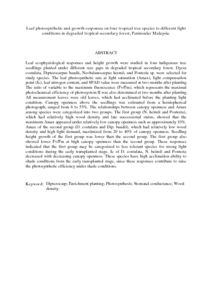Citation
Kenzo, Tanaka and Yoneda, Reiji and Matsumoto, Yoosuke and Alias, Mohamad Azani and Nik Ab. Majid, Nik Muhamad
(2008)
Leaf photosynthetic and growth responses on four tropical tree species to different light conditions in degraded tropical secondary forest, Peninsular Malaysia.
Japanese Agricultural Research Quarterly, 42 (4).
pp. 299-306.
ISSN 0021-3551
Abstract
Leaf ecophysiological responses and height growth were studied in four indigenous tree seedlings planted under different size gaps in degraded tropical secondary forest. Dyera costulata, Dipterocarpus baudii, Neobalanocarpus heimii, and Pouteria sp. were selected for study species. The leaf photosynthetic rate at light saturation (Amax), light compensation point (Ic), leaf nitrogen content, and SPAD value were measured at two months after planting. The ratio of variable to the maximum fluorescence (Fv/Fm), which represents the maximal photochemical efficiency of photosystem II was also determined at two months after planting. All measurement leaves were old leaves, which had acclimated before the planting light condition. Canopy openness above the seedlings was estimated from a hemispherical photograph, ranged from 6 to 53%. The relationships between canopy openness and Amax among species were categorized into two groups. The first group (N. heimii and Pouteria), which had relatively high wood density and late successional status, showed that the maximum Amax appeared under relatively low canopy openness such as approximately 10%. Amax of the second group (D. costulata and Dip. baudii), which had relatively low wood density and high light demand, maximized from 20 to 40% of canopy openness. Seedling height growth of the first group was lower than the second group. The first group also showed lower Fv/Fm at high canopy openness than the second group. These responses indicated that the first group may be categorized to less tolerant species for strong light conditions during the early transplanted stage. Ic of D. costulata, N. heimii and Pouteria decreased with decreasing canopy openness. These species have high acclimation ability to shade conditions from the early transplanted stage, since these responses contribute to raise the photosynthetic efficiency under shade conditions.
Download File
![[img]](http://psasir.upm.edu.my/23977/1.hassmallThumbnailVersion/Leaf%20photosynthetic%20and%20growth%20responses%20on%20four%20tropical%20tree%20species%20to%20different%20light%20conditions%20in%20degraded%20tropical%20secondary%20forest.pdf)  Preview |
|
PDF (Abstract)
Leaf photosynthetic and growth responses on four tropical tree species to different light conditions in degraded tropical secondary forest.pdf
Download (84kB)
| Preview
|
|
Additional Metadata
Actions (login required)
 |
View Item |

